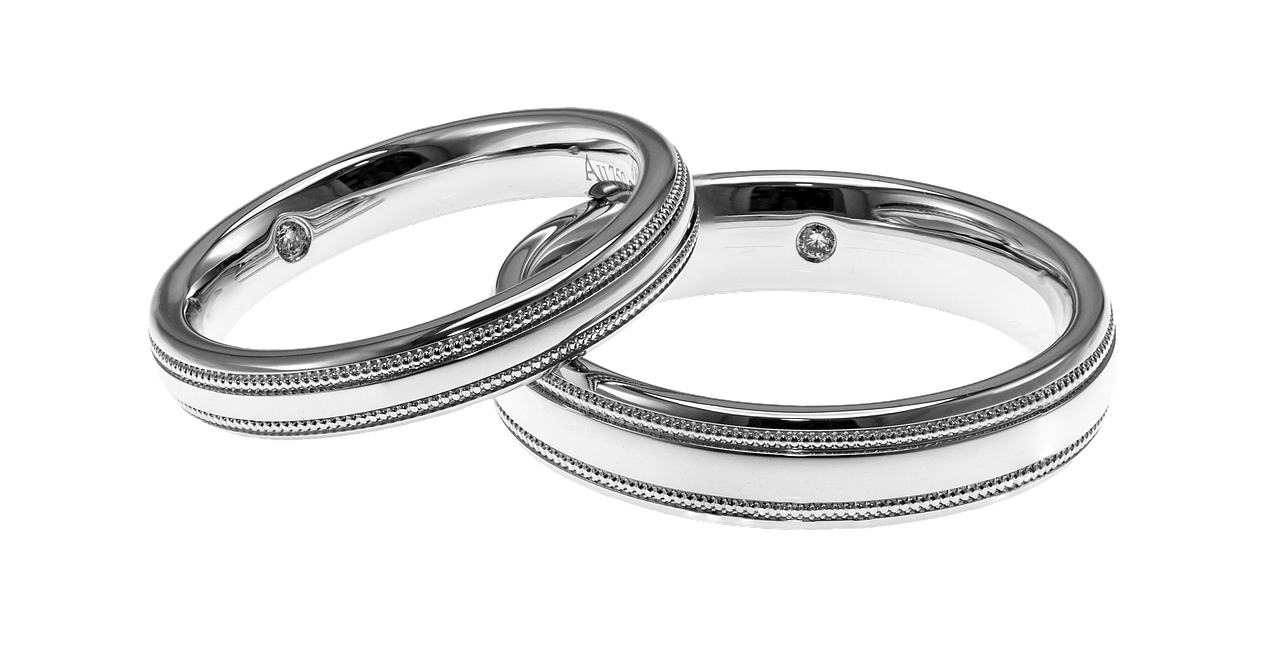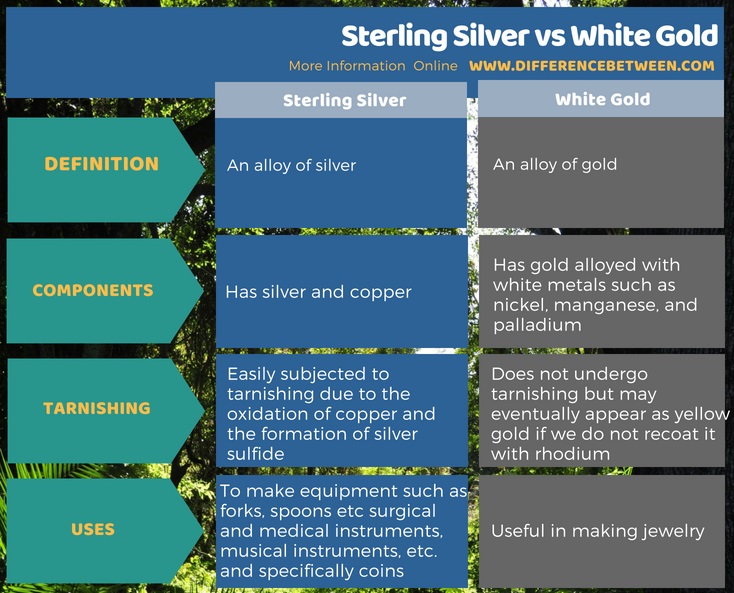Difference Between Sterling Silver and White Gold
The key difference between sterling silver and white gold is that sterling silver is an alloy of silver whereas white gold is an alloy of gold.
Silver and gold are very valuable chemical elements that are very popular in making jewelry and much other equipment due to their unreactive nature and the lustrous appearance. There are very few alloys of these elements. Usually, sterling silver, a silver alloy, contains copper other than silver while white gold, a gold alloy, contains a white metal such as nickel, manganese, and palladium.
CONTENTS
1. Overview and Key Difference
2. What is Sterling Silver
3. What is White Gold
4. Side by Side Comparison – Sterling Silver vs White Gold in Tabular Form
5. Summary
What is Sterling Silver?
Sterling silver is an alloy of silver. Most of this alloy is silver (about 93%) while the other element is usually copper (about 7%). Pure silver is very soft, but this alloy is relatively hard and strong due to the presence of copper. However, it is easily subjected to tarnishing. This is because copper oxidizes when exposed to normal air.

And also, silver sulfide (black colored) may form when exposed to airborne compounds of sulfur. Therefore, we can use metals other than copper in order to reduce the tarnishing. Some examples for the metals that we can use are germanium, zinc, platinum, silicon, and boron. This alloy is useful in making equipment such as forks, spoons, knives, surgical and medical instruments, musical instruments, etc. and specifically coins.
What is White Gold?
White gold is an alloy of gold. It has gold alloyed with white metals such as nickel, manganese, and palladium. We can give the purity of this alloy in karats. The properties of this alloy depend on the proportions of each white metal used with the gold. For example, when we use nickel along with gold, it gives a high strength alloy. But if we use palladium along with silver, it gives a soft and pliable alloy.

In addition, we can add some copper in order to increase the malleability of the alloy. The most common use of this alloy is to make jewelry. These jewelry are further coated with rhodium in order to increase the durability, strength and to give it a lustrous appearance.
What is the Difference Between Sterling Silver and White Gold
Sterling silver is an alloy of silver while White gold is an alloy of gold. Therefore, Sterling silver has silver and copper whereas White gold has gold alloyed with white metals such as nickel, manganese, and palladium. This is the main difference between sterling silver and white gold.
Furthermore, sterling silver is easily subjected to tarnishing due to the oxidation of copper and the formation of silver sulfide unlike white gold, which does not undergo tarnishing, but may eventually appear as yellow gold if we do not recoat it with rhodium. The uses of these two metals are; Sterling silver is used in making equipment such as forks, spoons, knives, surgical and medical instruments, musical instruments, etc. and specifically coins, and White gold is useful in making jewelry.

Summary – Sterling Silver vs White Gold
Alloys are mixtures of metals. We can mix metals with each other in order to get desired properties. Sterling silver and white gold are very valuable alloys. The difference between sterling silver and white gold is that sterling silver is an alloy of silver whereas white gold is an alloy of gold.
Reference:
1. “Sterling Silver.” Wikipedia, Wikimedia Foundation, 10 June 2018. Available here
2. “What Is White Gold? Everything You Need to Know When Buying Jewellery.” The Diamond Store Magazine, 2 Mar. 2018. Available here
Image Courtesy:
1.’Amore ring sterling silver II’By Mark Somma (CC BY 2.0) via Commons Wikimedia
2.’1510162′ by steven_yu (CC0) via pixabay
ncG1vNJzZmivp6x7pbXFn5yrnZ6YsqOx07CcnqZemLyue8OinZ%2Bdopq7pLGMm5ytr5Wau26%2F056ppaGenHq0tcuvnKtlkaOxbsPHoqueZZekuaV7